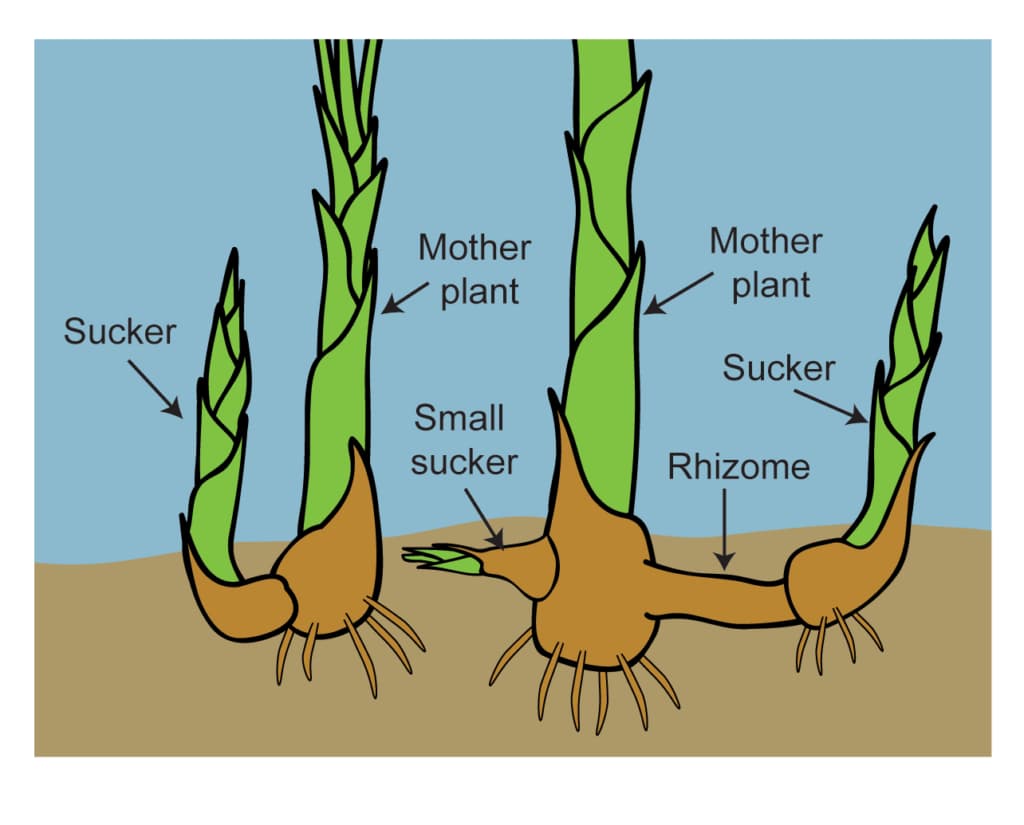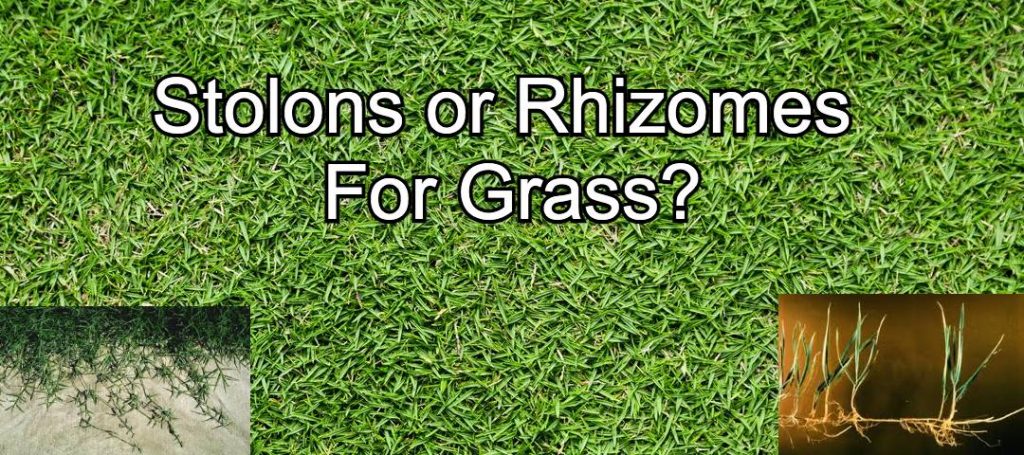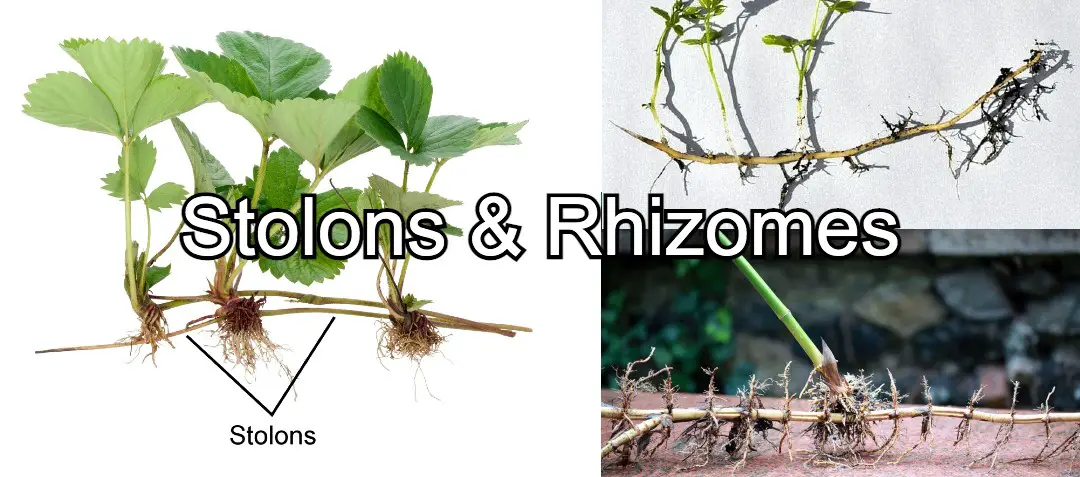Understanding the essence, key differences, and similarities between stolons and rhizomes is important for learning how creeping grasses can spread and recover from damage. The factual knowledge between the two can help you make the right decision as to what type of grass you should select for your lawn project.
Moreover, understanding the differences and similarities between Stolons and Rhizomes allows people to manage better and care for their lawn. Predominantly, stolons and rhizomes are fundamentals aspects of every plant to reproduce and spread.
You can define stolon as the ground-top stem that extends to the soil surface and grows another copy of the plant at the end root. Rhizomes are defined as creeping rootstalks that are essentially modified stems. These stems can horizontally run under the ground or underneath the soil surface.
What Exactly is Stolons?

The stolon refers to the existing stem offshoots of the plant. However, stolon may not come out from the stem. Often, the resemblance of the stolons comes across as the main stem, but their growth is horizontal. Furthermore, in place of roots, stolons have nodes and internodes, which makes the plant extended height. It is the sole reason stolons maintain a nickname of daughter plant.
However, stolons can stretch parallel straight to the ground when it comes to the strawberry plant and spider plant. If you live in a weather climate with harsh conditions, stolon can ensure the plant’s survival. In fact, it can withstand the most extreme weather conditions.
What Exactly is Rhizome?

The rhizome refers to a root-based stem that essential aspect of the main stem. It has a short and thick main stem that grows at a slow pace. It can grow in horizontal and other directions below the soil. The stem of the rhizome has nodes that spread out roots. Typically, the rhizome is essential to vegetative propagation and can increase the height of a new plant.
Generally, the rhizome is one of the main stems of plants such as iris, bamboo, Bermuda grass, ginger, poison-oak, and Chinese lantern. The horizontal growth of the rhizomes occurs in turmeric, while other rhizomes can grow below the soil area like the lotus.
The rhizome serves as the source of the root system for these plants. It is imperative to understand that rhizomes comprise nodes and as well as internodes. It is the reason that paves the growth of new plants. However, the growth of new plants largely depends on favorable weather conditions.
FUN FACT:
The runner name of the stolons comes from the fact that they can creep over the ground and spread horizontally above the soil. Ordinarily, there is much discourse and information on the stem, root, fruit, leaf, and flower.
However, if you want to learn about the asexual production and growth of plants, you will need to understand the basic differentiating factors of stolons and rhizomes. Practically, both stolons and rhizomes are central components of the stem of any plant and share various similar functions.
Stolons Vs. Rhizomes: Warm Season Grasses
Whether it’s Bermuda grass or St. Augustine grass, stolons and rhizomes can leave a different impact on warm seasonal grasses.
| Grass | Stolons | Rhizomes |
| Centipede Grass | No | Yes |
| Zoysia Grass | No | No |
| St. Augustine Grass | No | Yes |
| Bermuda Grass | No | No |
Stolons and Rhizome: Learn about the Key Differences
The following factors summarize the main differences between stolons and rhizomes:
Basic Definition
A stolon is a horizontal and creeping plant stem, which is famous for its other name as a runner. Its root has points in direct correlation to the length that continues the cycle to make new plants.
A rhizome, on the other hand, is a consistent underground or horizontal stem growth. It has a lateral direction and contains random interval roots.
Spread Rate
The rhizomes have a slow growth rate, whereas the stolons can spread fast.
Roots
Another key distinction between rhizomes and stolons boils down to their root system. Stolon cannot drive the rise of roots, whereas the plant’s root system emerges from the rhizome.
Growth Type
In terms of growth, the rhizome can strictly grow in a horizontal direction or underground, while the stolon can grow below the soil or on the soil surface.
Length and Thickness
Another visual feature that sets stolons and rhizomes apart is their length and thickness. Stolons are long and thin, whereas rhizomes are short and thick.
Relation to the Stem
When it comes to the stem, the stolon is not the main part of the plant, while the rhizome is, in fact, part of the central stem.
Vegetative Propagation
Another key distinction between the stolons and rhizomes lies in their vegetative propagation type. Stolons have unstructured nodes and roots while the shoots and roots emerge from the rhizome’s nodes.
Common Examples
Weeds, grasses, lily of the valley, and strawberries have stolon, whereas rhizomes contain iris, ginger, and canna lily.
NOTE:
Both rhizome and stolon are the specific parts that automatically drift further away from the plant. Also, rhizome and stolon are associated with vegetative propagation. Furthermore, both stolon and rhizome can function as nutrients’ storage parts.
Stolons and Rhizomes: Clear Distinctions
Presence
Stolons
Mostly, the stolons surface on top of the ground and stretch straight to the soil surface. Often, however, stolons can stretch a few inches over the soil ground.
Rhizomes
The rhizomes usually grow below the soil surface and technically are underground stems.
Internodes
Stolons
Both rhizomes and as well as stolons have internodes, but stolons have longer internodes than rhizomes.
Rhizomes
Rhizomes showcase relatively shorter internodes.
Length
Stolons
Stolons have a depressed and longer visual look. Its existing plant’s stem has elongated branches.
Rhizomes
Although the rhizomes are fleshy, they are relatively shorter as compared to stolons.
Thickness
Stolons
Comparatively, stolons are not flesh and come across as slim or trimmed.
Rhizomes
Rhizomes are fleshy and are fatter, bulkier, and thicker as compared to stolons.
Vegetative Expansion
Stolons
Stolons can spread at a much faster rate than rhizomes and cover a big area with its long branches. It makes stolons more efficient to increase the vegetative expansion at a faster rate.
Rhizomes
Rhizomes grow at a slow pace, which means they can cover a short distance in a long time. The short nature of rhizomes means they are not as efficient as stolons and increase the vegetative expansion at a faster rate.
Storage
Stolons
The overall capacity of food storage of stolons is less than rhizomes because of the narrow and thin growth.
Rhizomes
The thicker and bulkier growth of the rhizomes makes it a viable option for high storage capacity.
Stolons and Rhizome: What about the Similarities?

Although there is no long list of significant or precise similarities between the stolons and rhizomes, there are a few that make up integral similarities:
First and foremost, the rhizomes and stolons tend to separate from the plant. It is a process that paves the reproduction of the plant at another surface area. In simple terms, the process refers to the reproduction and propagation of plants asexually.
Food Storage Capacity
Another key similarity between the solons and rhizomes is their ability to store food, which paves the way for high vegetative reproduction. Once the root absorbs all the nutrients, it passes the same nutrients to the rhizomes and stolons.
Stolons and Rhizomes: What Else?
Evolution of Stolons and Rhizome Grasses
Over the centuries, rhizomes have managed to develop a defense mechanism from harmful hot weather conditions. The rhizome can withstand the motion of trampling with minimal damage. In fact, research claims that it improved the evolution of grasses after the cretaceous period.
Through the development of grass, you can trace back the source of nutrients for dinosaurs. Today, even after the consistent infrastructural development, the vast majority of Earth consists of grasses. The natural spread of the grass at a faster rate allows the ecosystem to thrive and flourish in the Asian steppe and American plains.
At some point, people experience small or large bare patches on their lawn. Therefore, it makes all the more reason to learn how the spread of the grass works and what elements can impact this growth. Nonetheless, don’t take the growth of the grass at face value; it is a continuous process that requires patience to see the long-term desired results.
Classification of Lawn Grasses
Subjectively, it is entirely up to you what kind of grass you prefer on your lawn. You can choose from two categories of rhizome grasses:
- Determinate
- Indeterminate
Rhizome Determinate Grass
Determinate rhizomes can quickly spread big or small bare patches. Rhizome determinate includes Kentucky bluegrass and creeping red fescue. These grasses can spread even on compact soils and have higher compatibility with clay soil.
Rhizome Indeterminate Grass
As the name suggests, the rhizome indeterminate grass can spread and cover long distances. So long as there is no obstacle in the way, they will continue to spread and grow laterally. However, indeterminate grasses are invasive and harder to control. The common example of indeterminate grass would be Bermuda grass, johnsongrass, and quackgrass. However, Bermuda grass is unique because it contains stolons and rhizomes.
Stolons and Rhizomes Frequently Asked Questions
What is the difference between a root and a rhizome?
A rhizome is essentially the main stem of the primary plant. But stolon can sprout from any stem, produces new shoots, and has extended internodes. The main plant utilizes the rhizome for the storage of starches and proteins.
What is the main purpose of stolons?
What is the function of rhizomes?
Are stolon and runner the same?
Is fungi a stolon?
What is plant reproduction in rhizomes?
Can you call strawberry a stolon?
Does jasmine classify as a stolon?
Does mint classify as a stolon?
Stolon Grass Vs. Rhizome Grass: Which is Better for Lawns?

The truth is both stolons and rhizomes come with unique benefits. However, the decision to choose between the two depends on the suitability and applicability of your lawn. For instance, stolon grass can endure rough hot climates.
But the best aspect about rhizomes grass is how quickly it forms the root and increases the growth. It is an excellent feature that can fill out empty patches of a lawn quickly. In northern climates of the U.S., for instance, this feature can work in favor of lawn owners throughout the year.
That said, if the grass is not native, the spread and growth pattern of rhizome grasses can be invasive in specific surface areas. If you want your lawn to look like a thick green carpet, a rhizome type of grass makes more sense. Since the rhizome spread and growth can spiral out of control, it requires a certain degree of check and balance.
There are grasses that can be rhizomatous and stoloniferous. However, in many instances, this kind of combination improves the visual appearance of the grass on the lawn. For example, you can choose Zoysia grass to get this combination.
Evidently, not every garden bed is non-invasive. For instance, the self-preservation and persistent qualities of the Bermuda grass are brilliant. However, a professional gardener would mention the consistent infestation of the Bermuda grass that can require endless troweling and shoveling.
The rhizomes and stolons can turn into a nightmare or the best thing for a lawn. Often, it sounds like a mystery as to how grass grows at a rapid speed on a lawn. There are many elements that can halt, slow, or speed up this process. As much as the botanical information matters, you have to take into account the wonder of nature to decide what would better suit your lawn.
The Case for Rhizome Grass for Lawns
Rhizomes may have had numerous evolutionary changes and continue to evolve. In fact, it goes as far back as 55 million years. Besides, nature takes its course, and rhizomes are advantageous for other plants.
Although both stolons and rhizomes are inherently invasive species, rhizomes’ subterranean nature offers a higher level of safety. It can also function as extensive storage for vegetative propagation. For instance, other plants have to form stem tubers, whereas rhizomes contains the plant’s main stem.
For example, turmeric and lotus plants are both edible. Once turmeric dries on the ground, you can use it as a spice. In essence, the key factor that makes it easier to choose between stolon and rhizome is the climate. Once you establish and clear this element, you can, for instance, select a native lawn grass with strong rhizome root.
Since rhizome grasses can grow bulkier and thicker, it makes an ideal choice for lawns. It is a cost-effective and quicker way to perform annual maintenance and weed control. The hardy and firm roots of the rhizome grass can withstand harsh climate issues like drought, traffic, heat, and even disease.
If you have kids and pets, rhizome grass makes a more compact and practical choice for your lawn. Mostly, people with multiple active dogs prefer to have rhizome type of grass that could withstand constant trampling. When the soil experiences bare patches, the grasses with rhizomes can automatically fill the surface area in a year and without hands-on assistance.
Healthy Roots is the Source of a Healthy Lawn
With stronger root systems of your grass, you can increase the chances to develop rhizomes. Once the grass takes permanent root, you can count on the root system to grow deeper into your ground and withstand tough weather conditions in summer.
However, once your grass grows and forms new roots, you can always divert your attention back to stolons spread. Again, fertilizer can make a huge difference for rhizome grass. You should opt for a fertilizer with a combination of phosphorous and nitrogen to ensure proper growth of the rhizome grass for your lawn.
Quick Summary
A stolon has a horizontal connection in multiple organisms. When it comes to plants, these stems can grow below or above the surface soil. You can see stolon or the runner in the strawberries, lily of the valley, weeds, and grasses.
Stolon is synonymous with its propagation strategy that makes it possible for plants to reproduce and spread out. It is a natural survival mechanism of stolon that makes it a viable choice for lawns. On the other hand, a rhizome has a main root-based stem that can grow in a horizontal direction or below the ground.
Technically, a rhizome refers to an underground plant’s stem that shoots from multiple nodes and spreads out the roots. The most common examples include canna, lily, iris, and ginger plants. When vegetative propagation comes into the picture, the separation of rhizomes is possible to grow new plants. Visually, the most common feature of stolons is that it is long and slender, whereas rhizome is short and thick.
Conclusion
View stolon through the lens of vegetative propagation for plants. Unlike rhizome, it is not part of the main stem but sprouts from it. It also stretches close to the surface area of the soil and paves the way for the growth of random nodes and roots. Conversely, a rhizome is a completely different kind of vegetative propagation.
In plants, a rhizome functions as the main stem and propels the growth of the roots. It’s the nodes of the rhizome that increase the growth of new plants. In hindsight, the fundamental aspect that sets stolon and rhizome apart is their connection with the stem and its structure.

